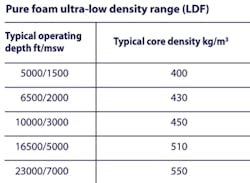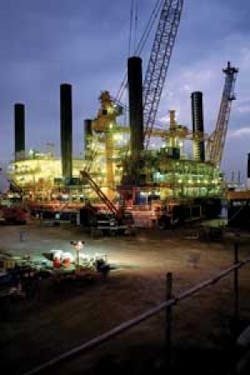Top, bottom kill prospects leave Macondo just a nasty memory
F. Jay Schempf
Contributing Editor
The custom-designed “capping stack” installed by BP over the damaged seafloor wellhead at the Macondo prospect in the Gulf of Mexico was removed in early September, with a switch-out of BOP stacks the next move in the company’s nearly five-month battle to combat what many have called the worst oil spill in U.S. history.
But even with the nightmarish experience of dealing with death, destruction, and pollution, BP plc, the main character in the so-called “Deepwater Horizon Explosion and Oil Spill” has a long way to go before things get right.
The capping stack – a temporary flow control mechanism placed atop the well’s original seafloor BOP in about 5,000 ft (1,524 m) of water – was installed in mid-July. It successfully stopped oil and natural gas production that had leaked at a rate that some estimates argue reached up to 60,000 b/d. The incident at the well site killed 11 workers and sunk Transocean’s fifth-generation ultra-deepwater semisubmersible rig,Deepwater Horizon. It occurred in Mississippi Canyon block 252 about 52 mi (84 km) southeast of Venice, Louisiana. The water depth involved is a record for such an incident.
Super-cautious, painstakingly deliberate action has dominated the work by BP and its contractors/subcontractors to tame the long-time-uncontrolled oil and gas flow from the well.
Under the oversight of a federal response task force headed by retired U.S. Coast Guard Rear Admiral Thad Allen – along with other federal and private watchdogs – BP made several unsuccessful “quick fix” attempts to gain control of the well in the weeks just after the spill. However, this culminated in the capping stack installation, which did the trick. Meanwhile, two relief wells were being drilled.
With the leak stopped, however, even more vigilance prevailed as leaders of the joint initiative decided not only to ultimately “kill” the flow at the reservoir level via the relief well, but also to ensure no unchecked flow was possible at the top-of-the hole area by achieving a “static” kill with drilling mud and a cement plug there, as well.
With the static kill accomplished in late August, the BP/federal response team then elected to ensure total overall control by removing the capping stack and theDeepwater Horizon’s damaged BOP, replacing them with a second full BOP stack supplied by Transocean’s mobile drilling/completion rig, Development Driller II.
This rig had been drilling the second relief well but had interrupted its work as the first relief well, being drilled by its twin, theDevelopment Driller III, neared its final interception point.
The relief well successfully penetrated the Macondo well’s casing to pump still more drilling mud and cement to stop any pressurized leaks from the formation into the hole, thereby concluding mechanical control of the 18,500-ft (5,639-m) ultra-deepwater well.
Smoke signals beckon
Retrieval of the damaged Macondo BOP may be tatamount to finding one of what could be several “smoking guns” implicated in theDeepwater Horizon blowout/fire and oil spill. That spill led to leaking oil stretching across large sections of the U.S. Gulf of Mexico, including numerous spots along the shorelines of at least three states – Louisiana, Mississippi, and Alabama.
Both civil and criminal charges could result from close inspection of the retrieved BOP and other Macondo equipment, and from testimony in a number of current and future hearings by a special panel created by US President Barack Obama, as well as by committees and subcommittees in both houses of Congress. The rhetoric coming from this jumble of independent investigations combines for a promise to get “to the bottom” of how the Macondo incident could have happened. Even the President said he was looking for whom to kick vis-à-vis its causes – both mechanical and personal.
It was no surprise that Gulf of Mexico exploration and development, particularly in deep and ultra-deepwater, would be curtailed – or even stopped – for a while as the blame game blossomed. However, when the President ordered Interior Secretary Ken Salazar to declare a six-month drilling moratorium in the Gulf in the early aftermath of the spill, the reaction by the industry came as no surprise either. Anti-moratorium appeals to both federal and state courts were filed by various industry groups, and then upgraded to cover changing specifications made by Salazar to outmaneuver them.
The industry challenges – backed stiffly by Gulf state governors, congressmen, and senators – predicted a disastrous backlash made up of delayed offshore production, lost jobs, and a mass exodus of deepwater drilling and support equipment to other producing regions of the world.
Many producing companies, they pointed out, would cancel their immediate plans for Gulf development in favor of onshore work or for offshore activity in more industry-friendly areas.
About that moratorium…
The moratorium, ordered in May, apparently had not resulted in such dire downturns, at least at press time. In fact, many producers as well as drilling and production services contractors anticipate that the stop-drilling order may be lifted earlier than in November, and a number of them have held on to their field personnel in anticipation of a return to pre-spill activity. Paint sales along the Gulf Coast likely have skyrocketed as companies create “busy work” for their people to keep them around at full (or partial) pay.
The damaged Macondo BOP, along with the lower marine riser package (LMRP) cap, have been removed from the Gulf of Mexico. Considered evidence in a Justice Dept. investigation, the entire package was moved to a secure onshore storage area for inspection. (U.S. Coast Guard photo)
Additionally, much of the oil spilled into the Gulf apparently has either been collected by skimmers on the surface and by workers on beaches and coastlines; has been burned; has been chemically dispersed; has evaporated; or is being consumed by bacteria, leaving a much less deleterious effect than first predicted on Gulf states residents and on regional industries, including fishing and tourism.
What’s more, BP plc, operator at Macondo for minority partners Anadarko Petroleum and MOEX Offshore 2007, a unit of Mitsui Oil Corp., has pledged to “be there” for the entire life of the spill and its after-effects, having set up a $20 billion fund (with a partial recoup via asset sell-offs) from which legitimate claims of damages suffered by businesses and individuals will be paid out by an independent settlement organization administered by presidential appointee Kenneth Feinberg.
The petroleum industry, in general, seems to have recognized the perils hidden within the business of technology-hungry deepwater exploration and production. Some companies already have reconstituted their in-house safety and training programs, and all of them seem to be quickly making changes ordered by the Interior Dept.’s Bureau of Ocean Energy Management, Regulation, and Enforcement (BOEMRE), the successor to the Minerals Management Service.
Everybody wants to help
In the wake of the blowout/spill, BP itself has partaken in a colloquy of new ideas from which both present and future offshore operations within the entire offshore industry perhaps stand to benefit.
While working closely with its contractors and subcontractors at Macondo, the company acknowledged that it also has worked openly with its competitors in the Gulf to help enhance technology targeted at stopping a spill at the wellhead, and cleaning up its effects in open water, the transition zone, and along the shoreline.
From the outset, BP’s website included a toll-free telephone number to which interested parties – that is anyone – could offer general assistance and/or submit alternative response technology, services, or product ideas.
Mike Utsler, COO for BP’s Gulf Coast Restoration Organization, formed to oversee the company’s long-term commitment to returning spill-affected area to its former condition, said more than 120,000 ideas were submitted to the telephone number by a range of industry members, as well as from scientific and environmental organizations, and even from private citizens.
“About two-thirds were focused on how to shut off the well and the rest were ideas on everything else regarding cleanup activities,” Utsler said in an unusual Aug. 31 question/answer session on Facebook. A team of scientists and subject matter experts reviewed the ideas and separated them into short-, medium- and long-term solutions, he added. From those, novel solution ideas were singled out for more intense study.
“We have actually converted hundreds of those ideas into solutions,” he said, including as examples the conversion of new barges into skimmers for use in both deep and shallow water; different tar ball recovery devices for both beaches and in tidal zones; and diverse technologies for source control below the water line, many of which were introduced into cleanup processes. “We continue to accept and take all ideas, evaluate them, and look for those that can be turned into solutions to support the response,” he said.
Litigation looms
The murky subtext beneath the whole Macondo universe, despite the good news, reads plain: The “blame game.” So:
- There are lots of allegations from many quarters
- There are many vengeful anti-oil senators and congressmen
- There are uncountable litigious attorneys
- There will be lawsuits and other court battles
- There may be mergers and acquisitions
- And there will even be more crazy stuff like movie actor Sean Penn’s pronouncement that the death penalty be invoked when dealing with any proof of criminal behavior in connection with the incident.
Onlookers can only wait, however, until the after effects make themselves known.
Offshore Articles Archives
View Oil and Gas Articles on PennEnergy.com


